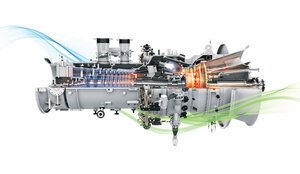
Gas turbines are designed to meet peaks in power demand very quickly. They operate drawing in air at the front of the unit, compressing it, mixing it with fuel and igniting it. The combustion occurs immediately allowing gases to then expand through turbine blades connected to a generator to produce electricity. Current iterations of gas turbines burn natural gas as source of fuel to generate electricity and according to current research hydrogen has the possibility of being a carbon free fuel instead of natural gas. These conditions places gas turbines are a favorable position in the energy scene due to their high fuel flexibility, short cycle, and their favorable performance. Hydrogen suffers in terms of safety, from a wide flammability range and a low ignition energy. It also poses a combustion challenge since its fast combustion renders the current premix DLE (Dry Low Emission) combustion technologies inoperative. Moreover, when burned in conventional diffusion flame, pure H2 develops hot flames and generate high NOx emission. Human health impacts tend to appear at peak exposures due to nitrogen oxides (NOx). In addition, NOx are precursors to ozone formation and contributes to the formation of smog and acid rain.
In order to combat these problems, the team came up with creative solutions. To mitigate the formation of NOx the team proposed to remove air and use pure oxygen as it’s replacement. This ensures that there is no nitrogen present for the formation of NOx. For the high temperatures produced due to the combustion of hydrogen and oxygen, we proposed to injection of high-pressured water to control the temperature of the reaction. These two solutions ensured that the only product from the combustion of hydrogen is water which is emitted as steam. Additionally, to make the plant carbon neutral the sourcing of hydrogen and oxygen can be done at the plant by electrolysis of water with the energy from renewable sources such as solar or wind using the excess energy produced during off peak hours. The produced hydrogen and oxygen are stored in storage tanks as fuel for the gas turbines to generate electricity in the future. These solutions recommended by the team makes hydrogen turbines not only a renewable source of energy but also a carbon neutral energy source. With efficiencies ranging between 40 – 60% of power generation. The team simulated this scenario using a computer simulation software called ASPEN HYSYS, to replicate the electrolysis and combined cycle power plant to better demonstrate the use of hydrogen turbines.
| Attachment | Size |
|---|---|
| 868.99 KB | |
| 1.68 MB |

